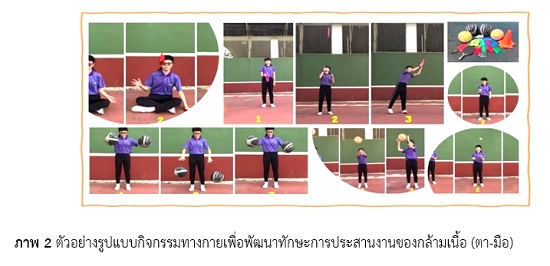THE DEVELOPMENT OF PHYSICAL ACTIVITY MODEL TO DEVELOP COORDINATION SKILLS OF MUSCLE (EYE-HAND) FOR GRADE 8 STUDENTS AT KASETSART UNIVERSITY LABOLATORY SCHOOL CENTER FOR EDUCATIONAL RESEARCH AND DEVELOPMENT
DOI:
https://doi.org/10.14456/nrru-rdi.2022.30Keywords:
Physical activity model, Coordination skills, Motor fitness, Secondary school studentAbstract
Children's bodies and intelligence should be developed according to their age. This quasi-experimental research aimed to develop a model to improve muscle coordination skills (eye-hand), conduct an experiment, compare, and evaluate the physical activity model for grade 8 students at Kasetsart University Laboratory School Center for Educational Research and Development. The sample group included 80 students selected with purposive sampling. Participants were randomly assigned and divided into two groups of 40 each: the treatment group and the control group. The Item-Objective Congruence (IOC) value of the physical activity model ranged from 0.80-1.00 and the evaluation form of satisfaction was 1.00. The physical activity model had a reliability score of 0.96. The program was implemented for eight weeks. The validity, suitability, and benefits of the model were analyzed by using the median and interquartile range. The experiment was analyzed by using two-way repeated measures ANOVA, while the satisfaction with the model was calculated into a percentage. The research revealed three findings. First, the physical activity model was valid, suitable, beneficial, and practical. Second, the treatment group improved muscle coordination skills (eye-hand) according to the training time, and the improvement in the treatment group was higher than the control group. Third, students and instructors were satisfied with the program at the highest level. In conclusion, the activities in the program contained diverse, interesting, and involved various equipment, resulting in suitable muscle coordination development.
References
Japan Sport Association. (2564). Phycical Activity Promotion in Children of Conceptual of ACP (Active Child Program). Bangkok : Kohken Printing. (In Thai)
Kaemkate, W. (2012). Research methodology in behavioral sciences. (3rd ed.). Bangkok : Department of Research and Educational Psychology, Chulalongkorn University. (In Thai)
Kaewmesri, B. (2002). Presentation of the Model for Development of Leadership Characteristics of Nursing College Administrators. under the Ministry of Public Health. Dissertation, Doctor of Philisophy Program in Education Administration, Department of Educational Administration, Faculty of Education, Chulalongkorn University, Bangkok. (In Thai)
Khamanee, T. (2017). Teaching Science and Knowledge for effective learning process management. Bangkok : Chulalongkorn University Press. (In Thai)
Kirkendall, D. R., Gruder, J. J., & Johnson, R. E. (1987). Measurement and Evaluation for Physical Educators (2nd ed.). Champaign, Illinois : Human Kinetics.
Krabuanrat, C. (2014a). Applying Fundamentals of Training (FITT). Journal of Health, Physical Education and Recreation, 40(2), 5-12. (In Thai)
Kuna-apisit, K. (2018). Physical Education Curriculum and Management (3rd ed.). Bangkok : N.d. (In Thai).
Ministry of Education. (2009). Basic Education Core Curriculum 2008. Bangkok : Office of the Basic Education Commission, Ministry of Education. (In Thai)
Nakhonkhet, K. (2015). Learning experiences from children's play according to the components of Boom, s Taxonomy. Journal of Health Education, Physical Education and Recreation, 41(2), 31-37. (In Thai)
North Carolina Division of Public Health. (2009). Move More North Carolina: Recommended Standarss for After-School Physical Activity. North Carolina : Raleigh.
Office of the National Economic and Social Development Board Office of the Prime Minister. (2016). The 12th National Economic and Social Development Plan 2017-2021. Retrieved January 6, 2020, from https://www.nesdb.go.th/ewt_dl_link.php?nid=6422 (In Thai)
Peanchob, W. (2018). Collection of articles on philosophy, principles, teaching methods, and measurements for evaluation in physical education (2nd ed.). Bangkok : Chulalongkorn University Press. (In Thai)
Physical Activity Research Center for Health. (2016). Survey of Physical Activity of Thai Children and Youth, 2016, Learn from Play. Bangkok : Green Apple Graphic Printing. (In Thai)
Robert, W. (2019). Alternate hand wall Toss test. Retrieved Feburary 8, 2020, from https://www. topendsports.com/testing/tests/wall-catch.htm
Rovininelli, R. J., & Hambleton, R. K. (1977). On the Use Content Specialists in the Assessment of Criterin Reference Test Item Validity. Dutch Journal of Educational Research, 2, 49-60.
Silamad, S. (2014). Physical activity for good health. Bangkok : Chulalongkorn University. (In Thai)
Srisa-ard, B. (2011). Preliminary research (9th ed.). Bangkok : Suviriyasan. (In Thai)
Suwankan, S. (2017). A Guide for Physical Activity Development for Developing Physical Literacy for Prathomsuksa 3 Students. Dissertation, Doctoral of Physical Education Program, Faculty of Education, Kasetsart University, Bangkok. (In Thai)
Waikasikam, P. (2020). The Development of Athletic Activities Model for Kids to Promote Fundamental Movement Skill of Elementary Students. Dissertation, Doctor of Education Program in Health Education and Physical Education, Faculty of Physical Education, Srinakharinwirot University, Bangkok. (In Thai)
World Health Organization. (2014b). Global Strategy on Diet, Physical Activity and Health. Recommended levels of physical activity for children aged 5-17 years. Retrieved April 2, 2021, from http:// www.who.int/teams/health-promotion/physical-activity/physical-activity-and-young-people
Yarbrough, C. K., Powers, A. K., Park, T. S., Leonard, J. R., Limbrick, D. D., & Smyth, M. D. (2011). Patients with Chiari malformation Type I presenting with acute neurological deficits: case series. Journal of Neurosurgery: Pediatrics, 7(3), 244-247.

Downloads
Published
How to Cite
Issue
Section
License

This work is licensed under a Creative Commons Attribution-NonCommercial-NoDerivatives 4.0 International License.




